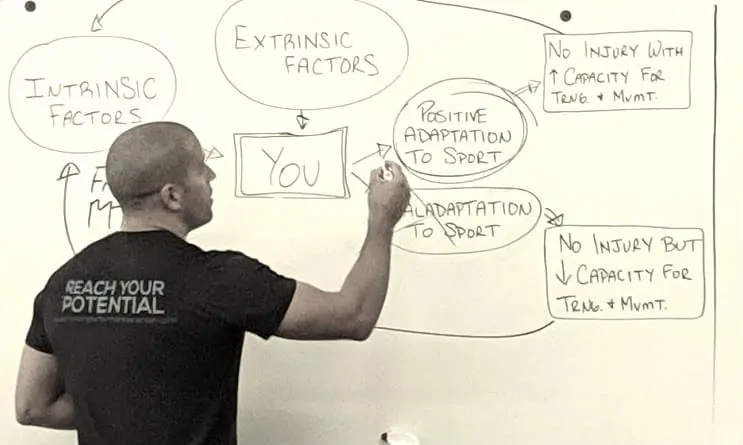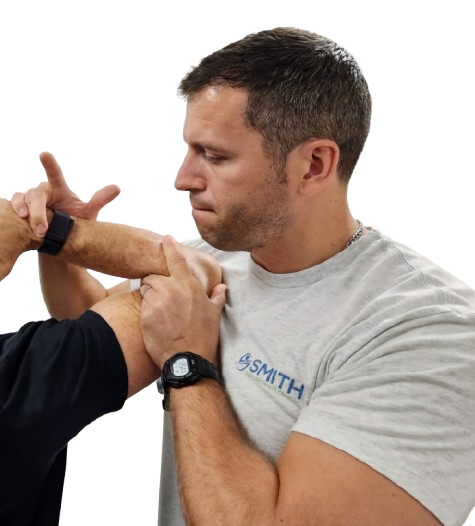What is a Trigger?
We use the term trigger as a catch-all term for the activities and movements during the day that makes symptoms worse. Trigger investigation is critical because they are the bane of feeling better.
The term, trigger, is an event that causes something else to happen.
You trigger the headache when you look over your shoulder.
You trigger back pain when you move from sitting to standing.
You trigger the shoulder pain when you reach for the shelf.
Sounds simple? Unfortunately, determining all of the triggers to your symptoms is as difficult as it is important.
- We obsess about triggers and draw boxes and lines going all over!
Why do we obsess on trigger management instead of building a huge list of physical therapy exercises?
Imagine this scenario. I am hitting a nail into the wall. Instead of hitting the nail, I manage to hammer my finger. I scream and drop the hammer. Then I stand there with a throbbing, partially hammered finger. My finger is going to hurt for several days. We call this a traumatic injury. Everyone who uses a hammer has made this mistake. The nail bruises a little and gradually feels better over the course of a week. None of this is complicated. The body heals itself.
But what if I decided to check if it was better by flicking my finger?
That’s dumb right? Why would you flick your finger?
That would obviously aggravate the pain.
What if you flick your finger more than once a day and flicked it 100 times? 1000 times?
Flicking your finger in this scenario is a trigger. As time progresses, you get better at feeling the pain in your finger. The receptors that send pain in the forever flicked finger grow more nerve endings.The receptors also reset their ‘action thresholds’ to require less stimulus to discharge, meaning even a light touch, not the stupid finger flick, becomes white lightening to the finger. Your brain starts to change a little so the representation of the finger gets bigger and blurred.
You start to avoid using the hand (except for when you flick the finger). Now pain occurs with most movements of your hand. At this point, the finger and hand have become sensitized and the whole process of getting better is much, much more difficult.
How do you treat this finger issue with physical therapy? Understanding the trigger management concept
The most common and worst way (authors opinion) to treat this finger issue? Telling a patient to stop using the hand.
BUT USING THE HAND IS NOT THE PROBLEM. The trigger (flicking your finger to see if its better) is the problem. The common recommendation to rest for 3-4 weeks before using the hand is short sighted and not actually treating the problem. Its avoidance.
Our team calls this fake improvement because the pain returns when hand use resumes.
Who flicks a finger after hitting it with a hammer?
I chose an example that highlights how easy it is to sabotage healing with triggers. Here is a more subtle example.
A runner is told to stop running due to pain and swelling in the knee. The runner when examined has clearly lost knee flexion during their running gait (a fancy term for your running pattern). The lack of knee flexion during loading response to midstance of running gait naturally occurs with knee joint swelling. You don’t realize it but the quad gets shut down with minimal joint swelling. The body instantly modifies the loading pattern because the quad is compromised, and voila, there is a loss of the needed knee flexion when you load. The trigger is keeping the knee completely straight for thousands of loading cycles because the quad is shut down. The treatment is simple – activate the quad and force the knee to have sufficient knee flexion during the gait cycle.
Our favorite anti-trigger technique is tell the runner that they must act like they are running in a room with a low ceiling. If they get too high, they will hit their head. Now running is no longer a trigger. While it sounds easy, the patient may require half the physical therapy session to get used to the pattern, but once its inserted in the trigger management plan, the process to healing speeds up.
Another common problem is being told to do activities that actually are triggers:
Stretching your hamstring after an acute disc injury in the low back.
High volume calf raises with an Achilles injury combined with swimming using the flutter kick. (Common problem in triathletes)
Neck stretching when you have a tight upper trap that is actually a facet injury (a facet is a joint in the neck).
Now back to the finger. If you decide to pick up your somewhat weird habit of flicking your finger after the 3-4 week break, the problem comes back. You cannot assume that it won’t just come back again because you have primed the body to feel it as painful. The hand starts hurting again with most activities.
What you really wanted to stop doing was flicking your finger. We want you to keep using the hand as much as possible.
Just stop flicking your finger.
Flicking the finger is the trigger.
Stop flicking your finger.
Is it really that simple?
In numerous pathologies, triggers are the key to getting better. If the trigger is performed 100 times in a day, how can you possibly feel better from a treatment that lasts 1 hour? Figuring out a trigger and developing a management plan in your physical therapy session, may require digging because it’s really difficult to know what it is in most cases without the following information:
Structural Diagnosis (what is causing the pain)
Functional Diagnosis ( what movements contribute to the pain)
What you are currently doing to treat it (could you be causing pain when thinking you are helping)
What makes it feel better over a week (not just momentary relief)
What makes it test worse or better in our exam
The key sign for the exam (the easiest re-testable thing that led you to seek help)
It is not simple. If it was simple, you have figured it out and would not be in need of treatment.
Mysterious buttock pain
Meet Brandi. She is an avid hiker with 3 kids. Over the past 6 months, she felt more and more pain the back of her leg and butt. She read online that the issue was her hamstring. In one of those articles, she found a series of stretches that target her problem. The well meaning authors tell her to do it 3 times per day. Every morning, she stretches her hamstring which seems to make her buttock pain reduce. During the hike, she stretches again when her pain starts to build. This allows her to get a couple more miles in. By the end of the hike though, her butt is screaming.
She thinks she has the solution to the problem for a while. Regrettably, the pain in the buttock starts to get worse and worse and worse. The past month, she stopped in the middle of a hike. The stretching stopped helping except for momentary relief.
Brandi just wants to hike. She is fed up and takes off hiking for one month. The pain disappears after two weeks!!! She found the solution. She starts to hike again, slowly building up her volume. After two weeks of building her mileage, she notices the buttock pain returning. At the end of the last hike, her pain spiked and she is back where she started 6 weeks ago. She attempts the stretching routine again, but the pain worsens. Brandi feels stuck and can no longer enjoy her hiking without a fear that the rest of her day will be a pain in the butt.
Literally.
But, I thought stretching was good?
Stretching is a tool, not a panacea for all musculoskeletal injuries. There is nothing bad or good about stretching. In some cases, it helps a lot. In some cases, it’s the trigger we must remove. A practitioner should build a theory during the first session, then test it to prove or disprove the attempted treatment methods.
In this real case of Brandi (name changed), the pain was a lumbar disc injury. She tested positive for a raging neural tension sign. A neural tension sign occurs when nerves coming out of the back become chemically sensitized by an injury which allows them to be ‘mechanically’ irritated. The most common neural tension sign we see occurs with low back injuries that cause you to feel tight hamstrings. The worst thing to do in this case is to stretch it
We uncovered the following triggers for Brandi:
Big steps (like the one used in hiking): Brandi hiked with her friend who was a foot taller. Brandi compensated by taking big steps. When her leg trailed behind her, the low back extended which immediately caused her buttock pain. When we examined her back, the ‘key sign’ was extending her back. By extending her back, she immediately felt the buttock pain (the TRIGGER). We told her to take small steps, not big steps.
Stretching hamstrings: When she started to stretch her hamstring, she irritated the neural tension originating from her low back (the TRIGGER). She stopped stretching after we talked about the neural tension sign.
Standing: Brandi stood with a lot of lumber extension. Normally this was not a problem but because she sensitized, standing for more than 30 minutes resulted in nasty, daylong buttock pain. The trigger is standing with the back in extension, so we provided several ways to stand that put the low back in mild flexion.
Common Trigger Mistake
The biggest error concerning our trigger talk is the assumption that you must stop the activity you love. We never take away the activity. Instead, we examine the components, then remove the problem component. For Brandi, hiking was not the trigger. Big steps causing lumbar extension triggered symptoms. This trigger was only set off with big steps while hiking. When she stepped smaller, she had no limit with hiking. She resumed hiking after talking with her tall friend about a pace change. This was we mean by trigger management compared to trigger elimination. If a doctor told you to quit hiking (which is a common recommendation people hear) then you are not solving a problem. In physical therapy, the trigger management plan should not eliminate an entire activity.
The other mistake which happens just as often, is to test the injured area to see if its improving. This would be fine if the test happened once a day. But what actually happens? The improvement test starts being used 50 times a day. Remember, flicking a finger you hit with a hammer makes no sense.
Summary
When we understand triggers, we understand the problem. When you develop a trigger management plan in your physical therapy plan of care, you will speed up your results. Now you can work on the problem 24 hours a day, instead of the one hour you spend with us in the clinic.








